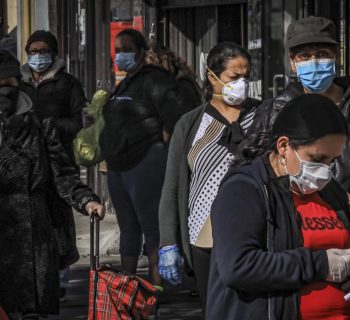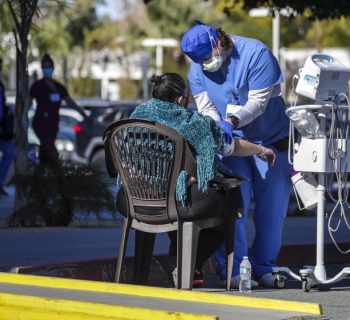The coronavirus pandemic has eaten away at the Latino edge in life expectancy in staggering fashion, and taken a disproportionate toll on older members of the community compared with whites.
By Ruben Castaneda | U.S. News & World Report | JUN. 1, 2022 | Photo by Jessica Pons
LOS ANGELES – In December 2020, about 10 months into the COVID-19 pandemic, Javier Perez-Torres boarded a bus from Los Angeles to Tijuana, Mexico, to buy a bracelet for the upcoming birthday of one of the five granddaughters who lived with him and his wife. Perez-Torres, 68, a Mexican immigrant, liked the selection of inexpensive jewelry available in the city just south of the U.S. border, so he made the trek, which lasted more than four hours round-trip.
Perez-Torres wore a mask on the bus. But shortly after he returned to his family’s apartment in the working-class neighborhood of Boyle Heights, just east of downtown Los Angeles, he fell ill with COVID-19. He suffered from a high fever, a hacking cough and body aches. His wife, Alicia Miron, and their five granddaughters also contracted COVID-19, but none became as ill as the patriarch, who ended up at nearby White Memorial hospital.
For more than a month, Miron went to the hospital to see her husband, who’d been intubated. But nurses – following COVID-19 safety protocols – wouldn’t let her in. She’d sit on a bench outside the hospital for hours, then go home, and repeat the process.
In early February of last year, a nurse called to let her know her partner of more than 40 years had died. She could now see him. “I said, ‘Why would I want to see him now?’” Alicia recalls in an interview in Spanish.
As of late May, there had been more than 80 million cases of COVID-19 in the U.S., with the disease taking the lives of more than a million people. And for myriad reasons, research indicates COVID-19 has exacted a disproportionate toll on older Latinos like Perez-Torres.
Overall, mortality from COVID-19 is some two to three times higher for Latinos than for non-Hispanic whites, says Dr. Michael Rodriguez, vice chair in the Department of Family Medicine at the David Geffen School of Medicine at UCLA. Rodriguez also is a professor in the Department of Community Health Sciences in UCLA’s Fielding School of Public Health.
“That’s an enormous difference,” Rodriguez says. The impact has been so dramatic that COVID-19 has diminished the so-called Latino (or Hispanic) paradox – a reference to the fact that for years, Latinos living in the U.S. have had a decided advantage in life expectancy over non-Hispanic whites. In 2019, for example, data from the Centers for Disease Control and Prevention shows Latinos’ life expectancy of 81.9 years was 3.1 years longer than the life expectancy for whites.
Latinos have maintained this type of edge despite generally having lower incomes, less access to health care and a greater prevalence of some chronic health issues, such as diabetes and obesity. Some researchers believe the life expectancy advantage is tied to the fact that many Latino immigrants to the U.S. are younger and healthier than many older Latinos, and have lower rates of smoking.
Yet in a study published in January 2021 in the Proceedings of the National Academy of Sciences, researchers from the University of Southern California and Princeton Universityestimated that COVID-19 deaths had shortened life expectancy in 2020 for all people in the U.S. by a little more than a year – to about 77.5 years – and that life expectancy for Latinos, specifically, plummeted by a little more than three years, to 78.77 years. That translated to a gap between whites and Latinos of less than one year.
The researchers used projections of COVID-19 mortality to reach their conclusions, and a follow-up study arrived at similar findings. A CDC analysis showing provisional life expectancy estimates also pointed to a three-year drop in life expectancy for Latinos, and a shrinking gap between Latinos and whites.
“A three-year reduction in life expectancy is huge in historical terms. We usually have not seen reductions this large except during times of war or major pandemics,” says Theresa Andrasfay, a postdoctoral scholar at the Leonard Davis School of Gerontology at USC and one of the PNAS study’s researchers. “Of course, it’s really sad to think about the individuals who died of COVID, but it also has broader implications for the family members of those who died.”
COVID-19 has not only claimed the lives of many older Latinos, but many younger, working-age Latinos as well, leaving behind children, siblings, parents and grandparents who depended on them, Andrasfay says. She says she and other researchers are working on an update, tracking the effect of COVID-19 on life expectancy in 2021: “We’re finding a similar pattern (to 2020), with Latinos having the largest reduction in life expectancy.”
Meanwhile, a separate study published online in September 2020 by The Journals of Gerontologydrew on provisional CDC mortality data from about the first seven months of the pandemic to show that older Latinos in four age groups – ranging from age 55 to 85 and older – had higher age-specific COVID-19 death rates compared with non-Latino whites. They had lower rates of death for non-COVID-19 causes than whites, but when looking at total deaths, the study shows the Latino advantage in death rate had either disappeared or all but disappeared among individuals 65 to 74 years old and 55 to 64 years old.

Over the entire year of 2020, older Latinos ages 65 and up died at more than twice the rate of older whites from COVID-19, according to a research brief published in May by Rogelio Saenz, a professor in the Department of Demography at the University of Texas at San Antonio, and Marc Garcia, an assistant professor of sociology at Syracuse University. Saenz and Garcia also authored the Journals of Gerontology Research study.
“Once you put all those together, what you find is you have the disappearing of the Latino paradox,” Saenz says.
While older Latinos have continued to have a higher rate of COVID-19 mortality than their white counterparts during each year of the pandemic, the difference in death rates has diminished over time. During the first year of the crisis, Latinos age 65 and older died of COVID-19 at 2.1 times the rate of older whites, Saenz and Garcia’s research shows. In 2021, older Latinos died at 1.6 times the rate of older whites, and into late April of this year, older Hispanics had died at 1.2 times the rate of older whites. Saenz attributes the narrowing difference to COVID-19 death rates among older whites in red states where vaccination rates are lower.
Overall, there is no single reason why older Latinos have been dying of COVID-19 at a higher rate than non-Hispanic whites, Saenz says. But it’s important to keep in mind, adds Garcia, that structural inequality in access to health care, education and well-paying jobs – as well as redlining practices and policies that segregated many Hispanics over the years in under-resourced neighborhoods – all have played a role.
Indeed, experts point to an array of factors that help fuel the disparity. Among them are:
Low rates of health insurance. In 2019, Hispanics in the U.S. had the highest uninsured rate among listed racial or ethnic groups at 18.7%, according to Census Bureau data. Only 50% of Hispanics had private health insurance – compared with nearly 75% of non-Hispanic whites – and the federal government reports the rate of public health insurance (such as Medicare and Medicaid) among different groups of Hispanics ranged from nearly 44% of Puerto Ricans to 33% of Central Americans. Overall, 20% of people of Mexican descent, 19% of Central Americans, 14% of Cubans and 8% of Puerto Ricans had no health insurance.
“It’s harder for (older Latinos) to get any kind of health care without health insurance,” Rodriguez says. “When they get exposed to COVID-19, they may wait until their condition gets worse. Now someone who could have been treated as an outpatient has to be hospitalized. And someone who has to be hospitalized has a higher risk of dying.”
Transportation, language and employment. A study in 2020 from the UCLA Latino Policy & Politics Initiative found Latinos (and Blacks) in Los Angeles County and New York City were roughly twice as likely to die of COVID-19 as non-Hispanic whites as of July 20 of that year, and noted that carpooling or taking public transportation to work may raise the risk of coronavirus exposure. The study also found that 34% and 37% of the populations in Los Angeles County and New York City were foreign-born, respectively, with Latinos making up the largest share of that population in each area. Approximately 13% of the foreign-born do not speak English, according to the report, which poses a challenge to their obtaining important health information.
Many Latinos also work essential jobs in venues like restaurants, meat-packing plants, hospitals, child care centers and retail stores. In California in 2018, 55% of Latino workers were employed in essential jobs, according to an analysis by the UC Berkeley Labor Center. These are jobs that typically can’t be done remotely, which puts workers in close contact with colleagues, members of the public or both. And while many older Latinos themselves may not be employed in these jobs, they may live with younger relatives who do, thus increasing their risk of contracting the coronavirus.
Cultural reasons. Latinos in the U.S. aren’t homogenous. They include millions of Mexican-Americans and Mexican immigrants in states like Arizona, California and Texas; Puerto Ricans, Dominicans, Cubans and people from other Latin American countries in places like metropolitan New York; large numbers of Salvadorans, Guatemalans and Hondurans in Los Angeles and Washington, D.C.; and people of Cuban, Colombian, Argentinian and Venezuelan descent, as well as many Central Americans, in the Miami region.
Latino subgroups have an array of political and cultural differences. But one cultural norm that cuts across all groups is the primacy of family. Whatever country they’re descended from, it’s not uncommon for Latinos in the U.S. to live in multigenerational households that often include young children, their adult parents and a grandparent or grandparents.
When young children and adults – many of whom are essential workers – live with elderly grandparents, “that increases the risk for the older people in the household,” says Dr. Luis Ostrosky, chief of the Division of Infectious Diseases at the McGovern Medical School at UTHealth Houston. “If the younger people in the household contract COVID-19, they may be OK, because younger people have stronger immune systems and tend to be healthier. Older people – who tend to be not as healthy and have chronic diseases – may become severely ill, with increased risk of hospitalization and mortality.”

Many people who live in a multigenerational home don’t have enough space to isolate effectively if one family member contracts COVID-19, says Dr. Efrain Talamantes, chief operating officer of AltaMed Health Services, the nation’s largest independent federally qualified community health center. Talamantes also sees patients in Boyle Heights, the working-class Los Angeles neighborhood where Perez-Torres lived.
“We’ve seen a lot of families where everyone – grandma, grandpa, mom, dad, the grandkids, nieces, nephews – tested positive,” Talamantes says.
High rates of certain chronic diseases. Latinos are significantly affected by a range of chronic diseases, according to the U.S. Department of Health and Human Services Office of Minority Health, including conditions that can make people more vulnerable to serious illness or deathfrom COVID-19, such as:
- Diabetes: Latinos have a higher rate of Type 2 diabetes than whites overall, with the risk varying by background.
- Liver disease: In 2019, chronic liver disease was the fourth-leading cause of death for Hispanic men between 45 and 64 years old. Hispanics also have been shown to be at highest risk of nonalcoholic fatty liver disease.
- Obesity: Hispanics in 2020 had the third-highest rate of obesity among adults at about 36%, according to an analysis by the Kaiser Family Foundation, behind Black adults and Native American adults.
COVID-19 Ends a Patriarch’s Eventful Life
Though he wasn’t in the best of health, Salvador Macias, 83, enjoyed going to a neighborhood community center for senior activities in Long Beach, a beachside city about 25 miles south of downtown Los Angeles. He lived in a modest, tidy house with his wife, Manuela, and their adult daughter, Julie.
Salvador suffered from three chronic health conditions: diabetes, high cholesterol and high blood pressure, says his son, Joe Macias.
In August 2020 – four months before health care workers received the first COVID-19 vaccine – the elder Macias became ill with the disease, suffering from fatigue and severe shortness of breath. After several days, Salvador died at home. Manuela, who doesn’t have the chronic health conditions her husband had, also contracted COVID-19. She was hospitalized for a week, but survived.

(BING GUAN FOR USN&WR)
The virus ended an eventful, colorful life. As a young man, Salvador had immigrated to the U.S. from Zacatecas, Mexico. He started out working with his brother in grape and almond fields in California’s agricultural region. Later, he worked as a handyman and then as a maintenance supervisor at a convalescent home in Echo Park, now a trendy, gentrifying neighborhood near downtown Los Angeles. Salvador planted corn on the grounds of the convalescent home, where he sometimes brought horses and goats to graze. City animal regulation officers cited him for an array of violations, which officials were unable to prove because Salvador only kept animals on the property for short periods of time, Joe Macias says.
Though his father wasn’t well-educated, “he was resourceful,” Joe says. He created a good, stable life for his family.
Salvador’s ashes are in a box-shaped urn atop the living room’s mantel, near several religious symbols: two statues of the Virgin Mary, and a wooden cross adorned with a peace dove.
“I miss him,” Manuela says. “It was the three of us – Julie, him and me. Now it’s just the two of us.”
This article was written with the support of a journalism fellowship from The Gerontological Society of America, the Journalists Network on Generations and The John A. Hartford Foundation. Castaneda was one of 17 distinguished reporters across the country selected to participate in the Journalists in Aging Fellows Program.







